President's Message
Our December meeting was most enjoyable. Many thanks to the Colonial Dance Club of Richmond for their instruction. The Colonial Dance Club meets at 8 o'clock every Wednesday night at Emmanuel Episcopal Church. The public is always invited and you don't need a partner to dance.
Many thanks also to all volunteers for their contributions. Lurline and Allan Wagner provided delicious refreshments. Special guest was Henrico Deputy Manager, Angela Harper, who was the lead staff for the 400th commemoration.
As mentioned before, the last project in 2011 for the 400th anniversary was the creation of the time capsule room located in the Administration Building at the Parham Government Center. Many items relating to Henrico County in 2011 were sealed in a room that had previously held pay telephones and will not be re-opened for 50 years. It would be interesting to know what Henrico will be like in 50 years.
Let's see... We'd have to be how old?
Many projects that originated as part of the 400th commemoration will be continued as legacies.
As one door closes, another opens. We are in the midst of commemorating the 150 anniversary of the American Civil War, which began in 2011 and will extend through 2015. Henrico County played a pivotal role during the conflict that divided the nation and which ultimately insured freedom for all people in our country.
Many projects have been the result of the Sesquicentennial commemoration. In case you missed it in the Richmond Times-Dispatch, the US Secretary of the Interior, Ken Salazar, announced at a news conference on the Glendale Battlefield, a $4 million federal grant to benefit land preservation at Richmond Battlefield Park. The land to be preserved with the new funds lies primarily on the Glendale and Malvern Hill Battlefields.
After much study, scholars have begun to realize the battles in Henrico were of as much importance as Gettysburg and Manassas.
The 21st century meets the 19th century: The Civil War Trust presents it growing series of smart phone "battle apps," the latest one focused on Malvern Hill. The Civil War Trust is the largest nonprofit battlefield preservation organization in the US. Its goal is to preserve our nation's endangered Civil War sites and to promote appreciation of these hallowed grounds through education and heritage tourism.
In 2010, tourism in Virginia generated $18.9 billion in revenue, provided $1.3 billion in state and local taxes and supported more than 204,000 jobs.
Governor Bob McDonnell is quoted as saying, "The history of Virginia is the history of our country," and we want all Americans and visitors from around the world to come to the Commonwealth to learn about this incredible history. Richmond is home to some of the most historic events in our country's narrative, and this partnership in preserving more of our battlefields will ensure that future generations will be able to learn about our past and inform the future of this great country.
But that the story is not simple. Beyond the battlefields is the epic struggle for freedom. What about the position of the free blacks? Do we understand today what the meaning of honor meant in the 1860's? What was the situation on the home front? The story is huge; and a series of programs presented throughout the commemoration will be held to identify those perspectives.
And it all happened right here in Henrico 150 years ago.
Sarah Pace
President
>Back to Top<
Enjoying Tea, Pastry, and Country Dance
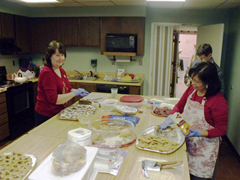
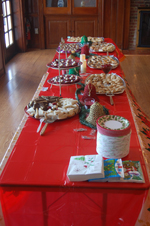
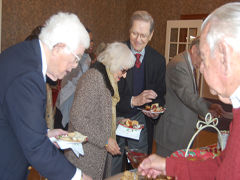
At the December 4 quarterly meeting held at the Belmont Recreation Center, members had a double treat - dance and delicacies. The Colonial Dance Club of Richmond demonstrated English Country Dance, explained the garments and materials typical of eighteenth century dress, and conducted a session of audience participation dancing where volunteers joined the dancers to try their hands, or actually their feet, at country dance. Then it was on to the reception room where guests sampled items from an elaborate table of backed goods set by Lurline Wagner and Debbie Shuck. Meanwhile, Lurline offered several teas to accompany the treats.
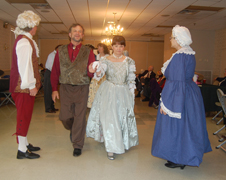
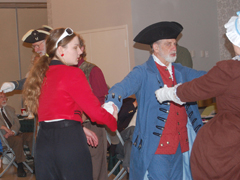
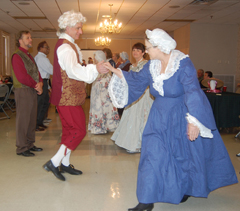
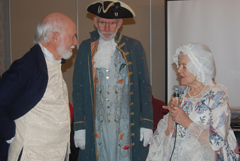
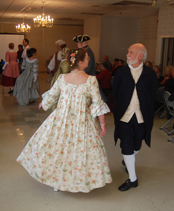
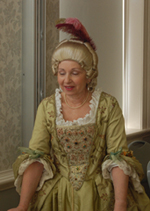
>Back to Top<
County Recognizes Young Historians
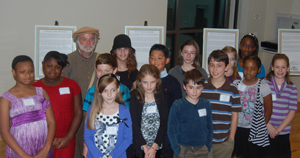
The Henrico Division of Recreation and Parks, Henrico Historic Preservation Advisory Committee, and Henrico Public Schools held their annual Historical Awareness Essay Awards Ceremony on November 29 at the Eastern Henrico Recreation Center. 15 fifth-grade students presented their award-winning essays describing how Henrico history has shaped the community today. Afterwards, they posed for a photograph with history interpreter Lindsay Gray.
>Back to Top<
Oyez! Oyez! Oyez! Calling All Virginians!
Family homes are prized possessions, and it can be challenging to pass them from one generation to the next. However, when we are able to do so, we gain a much fuller understanding of our ancestors' lives, surrounded by the furnishings and art that reflect their history.
For four years, Governor McDonnell and I have the honor of living in one of Virginia's oldest "family" homes - the Executive Mansion. Celebrating its 200th anniversary in 2013, the Executive Mansion is the oldest continually occupied governor's residence in all the fifty states. As you can imagine, this translates to a home full of history and stories of everyday family life. With the 200th birthday of the mansion approaching, we are looking to gain a more intimate understanding of this historic home, one that has not yet been told in the history books.
This fall, the official book of the Executive Mansion's 200th Anniversary will be released. Our commemorative coffee table book will chronicle the experiences of the fifty-four governors' families who have occupied the mansion. It is being written by Virginia historian Mary Miley Theobald, with an introduction by Virginia author David Baldacci and designed by Carol Roper Hoffler. We are also planning a yearlong celebration with special events, exhibits, and programs to commemorate this bicentennial.
I belive that the key to unlocking the untold stories of the mansion lies with the people of Virginia, and I'd like to involve you in this endeavor. If you are descendant of a former "First Family" or of someone who worked in the mansion, we'd love to hear your stories about your ancestors and the mansion. We are looking for old photographs of governors' families taken in the mansion and any letters and objects with a history of having been in the mansion that we might exhibit. You may have to dig them out of your great-great Aunt Matilda's trunk that's been sitting in Grandma's attic, but they will help shed light on this wonderful home's proud past.
If you have stories or images of Virginia's Executive Mansion, please join us in this opportunity to recapture them as we celebrate the bicentenneial. Please contact us by mail at Commonwealth of Virginia, Executive Mansion, P.O. Box 1475, Richmond, Virginia, 23218; or by email at Executive-Mansion@governor.virginia.gov, and help us bring the history of the Virginia's Executive Mansion to life!
With warmest regards,
Maureen McDonnell
First Lady of Virginia
>Back to Top<
Upcoming Historical Tours and Events
Please check our general events page for upcoming historical tours and events of interest!
>Back to Top<
Henrico's NASCAR Track Enters Its 60th Year of Beatin' & Banging'

When the green flag drops on April 28, 2012, Richmond International Raceway will begin its 110th NASCAR sanctioned race and enter its sixtieth year of serving up racing excitement on the NASCAR circuit.
The .75 mile D-shaped oval has been a fixture on the NASCAR schedule since 1953, when Lee Petty won the first NASCAR "Grand National Division" race. Not only was it the first NASCAR race at Richmond, but it was also the first NASCAR race in Virginia. At that time, the track was a .5 mile dirt track known as the Atlantic Rural Exposition Fairgrounds. Since then, the track has undergone four name changes (Atlantic Rural Fairgrounds, Virginia State Fairgrounds, Richmond Fairgrounds Raceway, and Richmond International Raceway), five configuation changes (.5 miles, .625 miels, .5 miles, .542, and today's .75 miles) and one surface change, from dirt to asphalt.
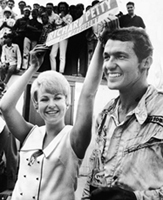
And those aren't the only changes. Petty won $1,000 and averaged just over 45 mph for that first 100-mile race, while last place finisher Coleman Lawrence collected a whopping $25. Last year's winner, Kyle Busch, took home almost a quarter of a million dollars and averaged just over 95 mph over the course of a 400-lap (300 mile) race. And Buck Baker's 48,465 mph lap earned the pole position in the 1953 affair, but it was a far cry from Bryan Vicker's track recod 129,983 mph qualifying lap set in 2004.
And some things didn't change much - like a Petty in victory lane. Richard Petty, son of the inaugural race winner Lee, first won at Richmond in 1961, and continued winning, posting a record 11 wins. Then in 1986, Richard's son, Kyle Petty, took the checkered flat at Richmond - the only track where all three in the family have posted wins. Richard Petty even drove one of the bulldozers that tore up the track for its final reconfiguration immediately following the Pontiac Excitement 400 in 1988.
Even before the track joined the NASCAR circuit, there had been races held there, starting in October of 1946, when Ted Horn won an open wheel race on the dirt track.
Hitting 60 makes many think about slowing down and going into retirement, but it looks as if Richmond International Raceway is doing anything but slowing down.
>Back to Top<
149th Fighter Bobmer Squadron of the Virginia Air National Guard and the Douglas A-26
By Tyler Turpin
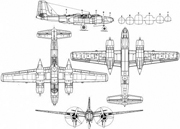
The Douglas A-26 was a twin engine World War II era attack aircraft used for level bombing, ground strafing, and rocket attacks. Production delivery began in August 1943. The A-26 entered combat over Europe in November 1944. When production halted after the war, 2,502 Invaders had been bult. The original version had a wing length of 70' and fuselage length of 51'3". The aircraft type remained in service with the USAF until 1969.
The 149th Fighter Bomber Squadron of the Virginia Air National Guard operated the Douglas A-26 Invader aircraft as a training and transport aircraft from 1947 until 1957 as its primary mission aircraft in the light bomber role from 1954 to 1958. The squadron was based at Byrd Field later to be known as Richmond International Airport in Henrico County from 1947 to 2007. In 2007, the unit relocated to Joint Base Langley Eustis to be an associate wing with the active duty USAF 1st Fighter Wing. In October 1962, the unit had been redesignated as the 192nd Fighter Wing.
When their service with the Virginia ANG ended, most of the VA ANG A-26s were transferred to USAF aircraft storage facilities and sold to private firms for scrap, reuse as corporate use passenger or cargo aircraft, firefighting or were retained in storage faciliites. The predecessor of today's U.S. Air Force Special Operations Command was the only organization at the active, reserve, or Air National Guard level to keep some in use. These were retained for training and research in tactics to counter rebel movements as many nations where Special Operations Command operated were still using piston engine aircraft.
As U.S. involvement in the wars in Southeast Asia increased, some of the A-26 Invaders were deployed to the combat zones. The aircraft were successful in the support of ground forces, but some were lost to enemy action and structural failures of the airframe. If the Invader were to see further use in the region, an improved version was needed. Since the mid 1950s, On Mark Aviation of Van Nuys, California, had been rebuilding surplus A-26 Invaders for use by corporations and civilian government agencies. The Air Force issued a contract to rebuild some of the A-26 Invaders still in the Air Force inventory, modifying the aircraft for use in civilian aviation and making additional changes for improved combat performance. The success in combat of these modified A-26 Invaders and of the single engine A-1 Skyrider aircraft showed the Department of Defense that there was still a need for an aircraft dedicated to the support of ground troops, wiht a long loiter over target area time, and capability for sustained combat operations lower than modern fighter and bomber operating height. From this need the design competition that led to the contract for the design and production of the A-10 Thunderbolt II was issued.
It is possible that the success in civil aviation use of some of the former Virginia Air National Guard A-26s that were converted by On Mark for civilian use helped to validate the plan to improve the A-26 that later led to the development of the A-10 Thunderbolt II have been one of the aircraft types used to suppress Al Queda and Taliban forces in Afghanistan since 2001. A-10s were used in the 1991 and 2003-2011 wars against Iraq and in the 1990s intervention in the former Yugoslavia.
>Back to Top<
Now You Know
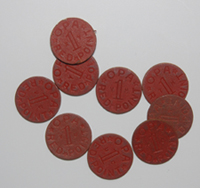
Congratulations to new members Ronnie and Nancy Grubbs, who correctly identified the small red cardboard discs seen at the right as tokens for rationing during World War II.
More specifically, these tokens were known as meat coins. They are marked "OPA," which stands for Office of Price Administration, and they were given as change when rationed meat and fats items were purchased.
In addition, the OPA issued blue coins, and these were given as change for rationed processed foods.
Wartime shortages meant food rationing and other homefront contributions:
Local Efforts:
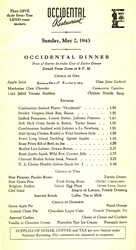
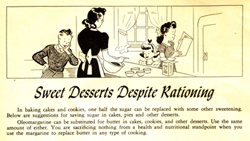
Restaurants like Richmond's Occidental included in their menus explanations of their use of sugar, coffee, tea, and other rationed items. Companies and organizations produced publications offering advice on adapting to rationing. The "Sweet Desserts Despite Rationing" came from the Virginia dairy pamphlet above.
Staples:
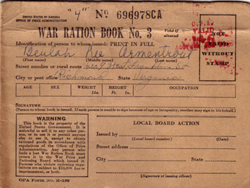
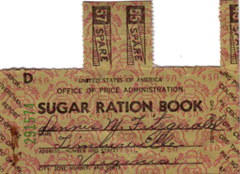
Americans were issued ration books in which they kept their ration stamps and coupons for everything from sugar to fish and cheese and meats.
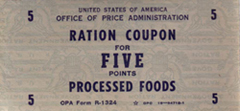
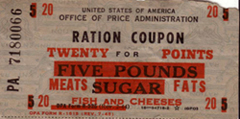
Kitchen Grease:
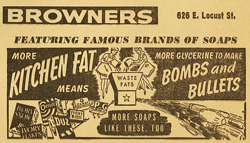
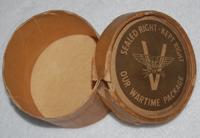
Production of explosives and other munitiosn required grease. Ads encouraged the saving of kitchen drippings. Those on the homefront were urged to save their kitchen drippings in cardboard cartons like that shown above and turn them in at collection sites.
Oil, Gasoline & Travel:

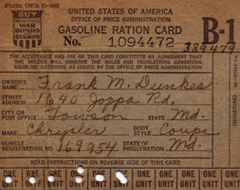
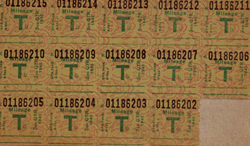
With the great need for petroleum products for the war effort, gasoline and fuel oil supplies were limited. Vehicle-specific gasoline ration cards and mileage ration cards were issued to drivers, as were mileage tickets. Tickets were also required to purchase fuel oil.
>Back to Top<
What Do You Know?
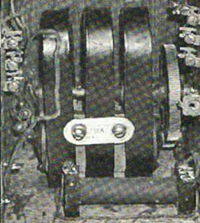
This three part iron object is roughly six inches tall and four inches wide. The wheel on the right is brass and has small teeth around its perimeter.
Do you know what it is?
Email your answers to: jboehling@verizon.net.
>Back to Top<
News 2012: First Quarter
Second Quarter | Third Quarter | Fourth Quarter
Home | Henrico | Maps | Genealogy | Preservation | Membership | Shopping | HCHS
|











